Navigate toolbar: [ Fish Diets | My Photos | Estuarine Research | FADs | Soniferous Fish | My CV | My Youtube | Children's Stories | Fish Facts | My Writings | Home Page ]
This page is outdated and will be updated soon
in the meantime see related publications.
Rountree, R.A., and F. Juanes. 2016. Potential of passive acoustic recording for monitoring invasive species: freshwater drum invasion of the Hudson River via the New York Canal System. Biological Invasions 19:2075-2088 DOI 10.1007/s10530-017-1419-z View paper online
Rountree, R.A., F. Juanes, and M. Bolgan. 2018. Air movement sound production by alewife, white sucker, and four salmonid fishes suggests the phenomenon is widespread among freshwater fishes. PLOS ONE 13(9): e0204247. https://doi.org/10.1371/journal.pone.0204247. View paper online
Rountree R.A., Bolgan M. & Juanes F. 2019. How Can We Understand Freshwater Soundscapes Without Fish Sound Descriptions? Fisheries 44(3):137-143. https://doi.org/10.1002/fsh.10190. View paper online
Rountree, Rodney A., Francis Juanes and Marta Bolgan. 2020. Temperate freshwater soundscapes: A cacophony of undescribed biological sounds now threatened by anthropogenic noise. PLoS ONE 15(3): e0221842. https://doi.org/10.1371/journal.pone.0221842 View paper online
A map of sampling locations with sound occurrence data:
First Survey of Aquatic Soundscapes in New England
Beginning Spring 2008
Title: Potential for the use of passive acoustic technologies in aquatic systems of North America - demonstration project in the major river systems of New England.
Principal Investigator: Rodney Rountree, Adjunct Assistant Professor, Department of Natural Resources Conservation, University of Massachusetts at Amherst.
Synopsis: Passive acoustics technologies have received little attention from fish and wildlife scientists and managers working in aquatic systems of North America. In its simplest form, passive acoustics is the act of listening to the underwater sounds made by fishes and other aquatic animals and using that information as an aid to study their habitat requirements and behaviors. I believe that with the advent of new acoustic technologies, passive acoustics will become one of the most important and exciting areas of aquatic research in the next decade. However, a widespread lack of familiarity with the technology, methodologies, and potential of passive acoustics has hampered the growth of the field and limited funding opportunities. I propose to conduct the first systematic study to characterize the underwater sounds from natural and anthropogenic sources in freshwater ecosystems of the New England region.
Objectives: The proposed project has two major objectives. First to collect data on ambient noise levels and begin to document the occurrences of major biological, natural and anthropogenic noises found in the major aquatic systems of New England. Second, to promote understanding of the science of passive acoustics and its application to wildlife, fisheries, and environmental conservation among regional aquatic scientists and resource managers.
Background: A new field of passive acoustics is rapidly emerging in fisheries science and marine biology, in which scientists use underwater technology to listen in on the noisy aquatic realm (Rountree et al. 2006, Gannon 2007, Luczkovich et al. 2007). Passive acoustics is distinguished from other types of bioacoustics, because it uses naturally occurring sounds to gather information on fishes and other marine organisms, rather than using artificially generated sounds. Passive acoustics provides a number of important benefits for fisheries research. First, it provides a method of non-optically observing fish activity and distribution. That is, it can be used to find and monitor fishes (and other animals) that produce sound. In addition, passive acoustics can also be used to simultaneously monitor sources of noise pollution, and to study the impact of man's activities on marine communities. Anthropogenic sources include noise generated by boating activity, seismic surveys, pile drivers, automobile traffic, sonars, fish finders, depth finders, drilling for oil and gas, and military activities. In aquatic systems, automobile traffic, construction and manufacturing activities can also generate significant underwater noise (Schwarz 1985). The importance of anthropogenic noise and its effects on marine mammals is widely known (NRC 1994, Perry 1998), but has only recently begun to be acknowledged and studied for fishes and invertebrates (Popper 2003). However, even less is known of the acoustic environment in freshwater systems, and an international team of scientists recently called for research (Rountree et al. 2006).
Passive acoustics is a powerful new tool to study the ecology of freshwater fishes (Rountree et al. 2006, Luczkovich et al. in press). By examining spatial and temporal trends in sound production we can determine spatial and temporal patterns of species occurrence and activity patterns for species important to the New England lakes and rivers (e.g. sturgeon, striped bass, catfishes, burbot, sunfishes, etc.). In cases where sound production is associated with spawning, we can infer essential fish habitat locations based on recordings of spawning and courtship sounds. For other fishes, we can use sounds made during feeding to determine daily feeding activity patterns (see review in Rountree et al. 2006). Unfortunately, very few studies have been conducted in North America to date. Recently, a pilot study of the Hudson River system conducted by an undergraduate student, working under the direction of Dr. Francis Juanes and myself at the University of Massachusetts at Amherst, revealed an extraordinarily rich array of underwater sounds. However, almost all of them were unidentifiable because of the extreme paucity of data on sound production by freshwater organisms (Anderson et al. in press). In addition, although our small study could not quantify ambient noise levels, we noted dramatic differences in apparent anthropogenic noise levels between river locations and between day and night samples. It is remarkable that so little is known about the acoustic environment for even the most important of freshwater systems in North America.
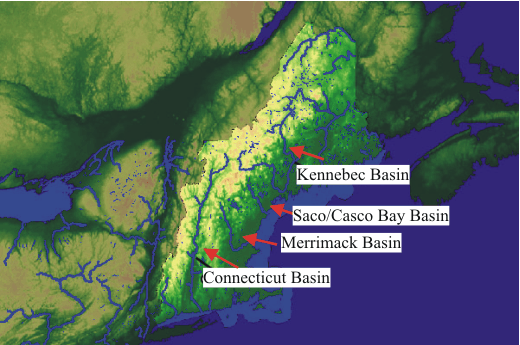 Figure 1. Map of the four major New England River Systems to be Surveyed in 2008. |
Description of the Approach: Pilot surveys will be conducted during the summer and fall 2007 in four of the major watersheds of the New England region (Envirocast, http://kyw.iewatershed.com/index.php), the Kennebec Basin, Saco/Casco Bay Basin, Merrimack Basin, and Connecticut Basin (Fig. 1). The purpose here is not to conduct a full-scale survey of the acoustic environment, but to document the diversity of sounds found in each area and demonstrate the extent to which scientists are still largely ignorant of this important aspect of aquatic ecosystems. Equally important, is the effort to involve local scientists, resource managers, and conservation specialists in the sampling so that they can see (or hear) for themselves just what they have been overlooking for so long. The most difficult component of the project will be planning of the field sampling so that representative data can be obtained for each system. Trips will be planned to maximize sampling of habitat types in each watershed while minimizing time lost in travel. Consultation with local scientists, wildlife officials and conservation groups will be critical to proper planning and successful sampling.
Study areas - The New England area contains at least 11 major basins (Envirocast 2007). The proposed project will sample in (from North to South) the Kennebec River Basin, combined Saco River and Casco Bay watersheds, the Merrimack River Basin, and the Connecticut River Basin (Fig. 1). These four watershed were chosen to optimize the diversity of freshwater habitats that could be surveyed within a reasonable geographic area. The Kennebec River Basin (Fig. 2) is the fifth largest watershed in New England at 5,900 square miles and includes the 145 mile long Kennebec River, the Belgrade lakes and Moosehead Lake. Primary sampling will be conducted in Moosehead Lake and the Kennebec River. The Saco Basin (Fig. 3) is 4,330 square miles. The largest river is the Saco that begins in the White Mountains and runs 120 miles to Ferry Beach, Maine. Other rivers include the Presumpscot and Piscataqua-Salmon Falls. For this proposal the smaller Casco Bay watershed (945 square miles) is considered together with the Saco Basin due to its proximity. The Casco Bay watershed is of particular interest because it is heavily impacted by development, and because of the work of the Casco Bay National Estuary Program (www.cascobay.usm.maine.edu). About a quarter of a million people (25% of Maine's population) live in the Casco Bay watershed. Primary sampling will include sections of the Saco River, Sebago Lake, and the Presumpscot River. The Merrimack Basin (Fig. 4) is 4,980 square miles and is the sixth largest in New England. The Merrimack River is 110 miles long and originates in the White Mountains of New Hampshire. It was an important center of industry during the industrial revolution and has been heavily impacted by urban and industrial activity. Primary sampling will be conducted in Lake Winnipesaukee and selected locations along the upper, middle and lower portions of the Merrimack River. The Connecticut River watershed (Fig. 5) is by far the largest of the watersheds in New England at over 11,100 square miles. The Connecticut River travels over 410 miles from the Canadian Boarder to Long Island Sound. Because of the large size of this system, monitoring will be mainly along the middle reaches of the river in western Massachusetts near the University of Massachusetts Amherst campus.
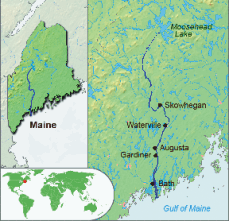 Figure 2. Map of the Kennebec River. |
 Figure 3. Map of the Saco River and Casco Bay watershed. |
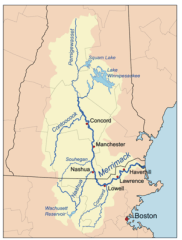 Figure 4. Map of the Merrimack River. |
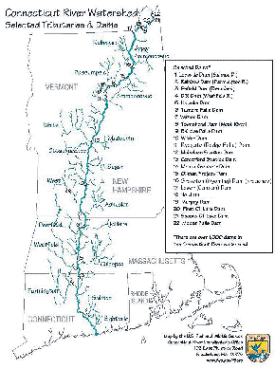 Figure 5. Map of the Connecticut River. |
Basic sampling method - The four watersheds will be visited for a period of five days each during which time acoustic monitoring will be conducted in a variety of habitats during both day and night periods. The basic sampling is quite simple, and consists of using a hydrophone connected to a laptop computer to record underwater sounds at specific sites (Fig. 6). Sampling can be done from shore, from bridges, piers and docks, as well as from small boats, canoes and kayaks (Rountree et al. 2006, Anderson et al. in press).
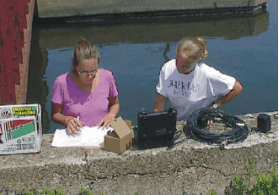 Figure 6. Passive Acoustic sampling in the Hudson River (Anderson et al. in press). |
The hydrophone will consist of a HTI-96-MIN hydrophone (High Tech Industries, Gulfport, MS; sensitivity: Sensitivity -165 dB re: 1 V/uPa, frequency response: 2 Hz to 30 KHz) connected to 33 m of cable. Acoustic data will be captured using RAVEN, Signal or other software and stored to external drives (Fig. 7). In addition, a microphone will be used to dub voice notes onto the sound track to aid in sound identification and processing. Both roving and fixed station acoustic surveys will be conducted. During roving surveys we will seek to collect short acoustic samples (approximately 5-10 minute duration) from a wide range of habitats during both day and night periods. The roving survey will provide instantaneous and short-term measurements of ambient sound levels in a wide range of locations for comparison with the fixed stations. It will also increase the potential exposure to various biological, natural and anthropogenic sound sources. Data on environmental parameters, most importantly temperature (which affect sound characteristics) will be collected along with acoustic data. Travel among sites will be accomplished by car, boat, canoe, kayak or on foot as appropriate. In addition fixed stations will be established to collect more extensive site-specific data during morning and sunset periods to compare the acoustic environments between day and night. The morning period of 0900-1100 will represent a daytime sample. A sunset monitoring period of three hours duration, starting approximately one hour before and ending approximately two hours after sunset, will be emphasized because biological acoustic activity often peaks at this time. Data generated from the roving and fixed station sampling will provide a preliminary picture of the ambient noise levels in each system, as well as an indication of the diversity of biological, natural, and anthropogenic sounds that are present in the acoustic environment.
 Figure 7. Example of a fish sound from the Hudson River (Anderson et al. in press). |
Sound source identification - Unfortunately, we know from our pilot freshwater study in the Hudson River (Anderson et al. in press) that many of the biological sounds that we observe will be from unknown sources because sound production characteristics of most of the soniferous freshwater fishes of New England have not yet been studied. Several steps will be taken to attempt to identify the sources of anthropogenic, natural, and biological sounds. First, all sampling will be monitored and voice notes recorded simultaneously to identify anthropogenic (e.g., boat noise, wakes), natural (rain, wind), and biological (fish, frogs, aquatic insects, and birds). The ability to distinguish sound sources arising from terrestrial sources (e.g., birds, non-aquatic insects) and aquatic sources (e.g., fish) is particularly important and can be accomplished in this manner. In addition, we will actively seek to record underwater sounds generated from observed anthropogenic activities in order to develop a reference catalogue. Most importantly we will capture fishes for auditioning experiments. Fishes will primarily be captured by hook-and-line, but other methods such as seine and gill nets will be used as opportunity arises (see outreach section below). Potential soniferous activity will be monitored during capture to document disturbance calls. In addition, fishes will be held for short periods in water filled coolers and in cages suspended in the water in order to monitor them for potential sound production. Most fishes will be returned to the water alive, however a few specimens for which validated sound recording were obtained will be preserved to serve as museum voucher specimens. This methodology was successful in our previous small pilot study of the Hudson River (Anderson et al. In press).
Scientific outreach: An important component of this project is to educate local scientists, resource managers, and conservationists on the importance of the acoustic environment and how it can be studied. Towards this aim, I will seek to develop contacts among scientists and agencies in each of the areas and encourage them to participate in the acoustic sampling in their area. For example, scientists at the Casco Bay National Estuaries Program will be encouraged to participate in sampling of the lower Presumpscot River. In addition, I will arrange to give a seminar on the aquatic acoustic environment in each of the regions to inform local scientists and students. It is hoped that cooperative sampling by local scientists, wildlife officials and students will enhance the data collection. In particular, collaborators that participate in the fixed station monitoring can greatly increase the number and diversity of fishes that can be auditioned for sound production through capture of fishes with various sampling gear available to them (e.g. seines, pop-up nets, cast nets, trawls, gill-nets, and hook-and-line. I believe that bringing scientists and resources managers in the field where they can experience the acoustic environment themselves will do more to promote efforts to study and conserve the acoustic environment of our aquatic ecosystems than just about anything else.
Impacts: Despite the growing awareness of the importance of the acoustic environment in marine systems (Schwart 1985, Popper 2003, Rountree et al. 2006), its importance to freshwater aquatic ecosystems has not been widely recognized. The proposed project will have two major outcomes. First it will generate preliminary data on the underwater acoustic environment of four important river drainage systems in the New England region of the United States. The findings from this project will be used to support proposals to conduct full-scale studies in the region to more fully document natural and anthropogenic sources of noise in these system. The lack of previous studies in this area indicates an extraordinary gap in the aquatic sciences and reflects an urgent need for conservationists to recognize the importance of the acoustic environment to aquatic wildlife. Secondly, by actively engaging local scientists and resource managers in the field work, and by conducting introductory seminars for local institutions and agencies, this project will both educate local fisheries and aquatic wildlife and conservation specialists and stimulate regional interest in acoustic research. It is hoped that in time this combined approach will result in an increased appreciation among local, state and federal fisheries and wildlife agencies and academia for the need for research on the acoustic environment to promote the wise use, management and conservation of our aquatic resources.
References
Anderson, K. A. R. A. Rountree, and F. Juanes. 2007. Soniferous Fishes in the Hudson River. Trans. Am. Fisher. Soc.
Gannon, D. P. 2007. Passive Acoustic Techniques in Fisheries Science: A Review and Prospectus. Trans. Am. Fisher. Soc.
Luczkovich, J.J., D.A. Mann and R.A. Rountree. 2007. Passive Acoustics as a Tool in Fisheries: An Introduction to the American Fisheries Society Symposium. Trans. Am. Fisher. Soc.
Perry, C. 1998. A review of the impact of anthropogenic noise on cetaceans. Report for
the environmental Investigation Agency, London, UK.
Popper, A. N. 2003. Effects of anthropogenic sounds on fishes. Fisheries 28(10):24-31.
Rountree, R.A., R.G. Gilmore, C.A. Goudey, A.D. Hawkins, J. Luczkovich, and D. Mann. 2006. Listening to Fish: applications of passive acoustics to fisheries science. Fisheries 31(9):433-446
Scheifele, Peter M. and Michael Darre. 2005. Noise levels and sources in the Stellwagen Bank National Marine Sanctuary and the St. Lawrence River Estuary. Marine Conservation Series MSD-05-1. U. S. Department of Commerce, National Oceanic and Atmospheric Administration, Marine Sanctuaries Division, Silver Spring, MD. 26pp.
Schwartz, Abby L. 1985. The behavior of fishes in their acoustic environment. Environmental Biology of Fishes 13(1):3-15.
p style='margin-left:1.0in'>
Return to: | TOP |
This page was last modified on Sept 25, 2007
Copyright © 1999, 2003, 2004, 2005, 2007 by Rodney Rountree. All rights reserved
Navigate toolbar: [ Fish Diets | My Photos | Estuarine Research | FADs | Soniferous Fish | My CV | My Youtube | Children's Stories | Fish Facts | My Writings | Home Page ]